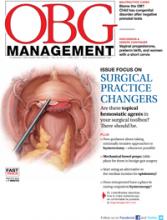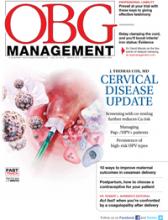“UPDATE ON MINIMALLY INVASIVE SURGERY”
AMY GARCIA, MD (APRIL 2012)
Minimally invasive surgery is not always the best option
The AAGL and OBG Management are acting irresponsibly by implying that physicians who perform abdominal hysterectomy are not taking good care of their patients. Many of our patients simply are not candidates for a minimally invasive approach. Dr. Garcia ignores the broad range of patient clinical presentations and the wide variation in surgical training available throughout the United States.
In addition, when AAGL proposes that surgeons act in concert with insurance companies to encourage the minimally invasive approach, the organization goes way past the line of responsibility to our profession. To suggest that physicians attack each other in the form of economic credentialing goes beyond the pale.
David Rogers, MD
Dallas, Texas
Dr. Garcia responds The AAGL seeks to improve the quality of women’s surgical care
I agree that the AAGL makes a bold statement. I think it is important to clarify that statement here because it is intended to improve the quality of surgical care for women.
The AAGL position statement acknowledges that abdominal hysterectomy may be the best option in some cases:
- when the patient has a medical condition, such as cardiopulmonary disease, that elevates the risk of general anesthesia or renders the increased intraperitoneal pressure associated with laparoscopy unadvisable
- when morcellation is likely or known to be required and uterine malignancy is known or suspected
- when hysterectomy is indicated but there is no access to the surgeons or facilities required for vaginal hysterectomy (VH) or laparoscopic hysterectomy (LH), and referral is not feasible
- when anatomy is so distorted by uterine disease or adhesions that a vaginal or laparoscopic approach is not deemed safe or reasonable by individuals with recognized expertise in either VH or LH techniques.
I do understand that, in some places, no experienced minimally invasive surgeon may be available. However, when there is someone with the requisite surgical training, skills, and experience to perform vaginal or laparoscopic hysterectomy, then the patient should be referred to that surgeon, or the help of that surgeon should be enlisted to avoid an abdominal procedure.
We have too much clinical evidence of the benefits of these minimally invasive surgical procedures over abdominal hysterectomy to stand in the way of providing women with access to better care just because we lack the ability to perform them ourselves. The AAGL calls us to a higher level of responsibility and patient care. I applaud its courage.
“ACT FAST WHEN CONFRONTED BY A COAGULOPATHY POSTPARTUM”
ROBERT L. BARBIERI, MD (EDITORIAL; MARCH 2012)
For a postpartum coagulopathy, start with cryoprecipitate
My first chairman (and mentor) taught me to administer cryoprecipitate before any other clotting factors. Cryoprecipitate is the richest source of fibrinogen and carries the least volume load for the patient. Hypofibrinogenemia is at the root of most coagulopathies associated with obstetric complications. Cryoprecipitate quickly solves the problem without adding to the fluid overload.
Genevieve B. Sicuranza, MD
Mineola, New York
Three additional steps can help identify and resolve coagulopathy postpartum
I appreciated Dr. Barbieri’s recommendations for identifying and managing a coagulopathy postpartum. I’d like to offer three additional suggestions:
- inspection of the placenta and manual examination of the uterus to rule out retained products of conception
- establishment of a protocol for preparing blood products as soon as possible, as Dr. Barbieri suggested, including drills every 3 months
- immediate consultation with a hematologist—in person or by phone.
This protocol should be in every labor and delivery unit. It’s the kind of proactive, life-saving protocol the Joint Commission ought to be emphasizing instead of its usual nitpicking.
Richard Stokes, MD
Reston, Virginia
Is thromboelastography useful?
Dr. Barbieri’s editorial on postpartum coagulopathies was timely and useful. I will be checking with the lab in my small district hospital about the availability of RiaSTAP (lyophilized fibrinogen concentrate [human]; CSL Behring).
A recent article in another journal on the same topic mentioned thromboelastography (TEG). What is Dr. Barbieri’s opinion of TEG?
K. Pang, MD
Tulare, California
Dr. Barbieri responds An experienced and alert clinician may be the best remedy
I thank Dr. Sicuranza for her succinct point: If your patient has a post- partum coagulopathy, the best treatment is fibrinogen. I agree with her advice. One challenge is that many blood banks need to thaw cryoprecipitate before making it available to the patient, and thawing routinely takes 30 minutes. In contrast, most blood banks have prethawed, fresh, frozen plasma on hand that can be sent to the patient-care area within 5 minutes.
A new option is RiaSTAP, a lyophilized formulation of fibrinogen. The usual dose of RiaSTAP for postpartum hemorrhage is 2 vials. Compared with fresh frozen plasma or cryoprecipitate, RiaSTAP is very expensive.



